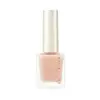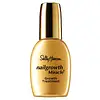What's inside
What's inside
 Key Ingredients
Key Ingredients

 Benefits
Benefits

 Concerns
Concerns

 Ingredients Side-by-side
Ingredients Side-by-side

Butyl Acetate
MaskingEthyl Acetate
PerfumingNitrocellulose
Alcohol Denat.
AntimicrobialAcetyl Tributyl Citrate
MaskingAdipic Acid/Neopentyl Glycol/Trimellitic Anhydride Copolymer
Isopropyl Alcohol
SolventSilica
AbrasiveAcrylates Copolymer
Water
Skin ConditioningStearalkonium Bentonite
Gel FormingGlycerin
HumectantStyrene
PerfumingT-Butyl Alcohol
PerfumingDimethicone
EmollientOctocrylene
UV AbsorberTrimethylpentanediyl Dibenzoate
Polyvinyl Butyral
Hydrogenated Lecithin
EmulsifyingTitanium Dioxide
Cosmetic ColorantPolyglyceryl-10 Tristearate
Skin ConditioningPanthenol
Skin ConditioningCI 77491
Cosmetic ColorantSodium Ascorbyl Phosphate
AntioxidantMethyl Alcohol
SolventNiacinamide
SmoothingCI 19140
Cosmetic ColorantDipropylene Glycol Dibenzoate
EmollientStearalkonium Hectorite
Gel FormingDenatonium Benzoate
MaskingEthylcellulose
Acetaldehyde
MaskingBiotin
AntiseborrhoeicHydrolyzed Keratin
HumectantPyridoxine
Skin ConditioningCI 77266
Cosmetic ColorantPhenoxyethanol
PreservativeAcetone
SolventCamphor
MaskingCyanocobalamin
Skin ConditioningTocopherol
AntioxidantBeta-Carotene
Skin ConditioningRiboflavin
Cosmetic ColorantThiamine Hcl
MaskingButyl Acetate, Ethyl Acetate, Nitrocellulose, Alcohol Denat., Acetyl Tributyl Citrate, Adipic Acid/Neopentyl Glycol/Trimellitic Anhydride Copolymer, Isopropyl Alcohol, Silica, Acrylates Copolymer, Water, Stearalkonium Bentonite, Glycerin, Styrene, T-Butyl Alcohol, Dimethicone, Octocrylene, Trimethylpentanediyl Dibenzoate, Polyvinyl Butyral, Hydrogenated Lecithin, Titanium Dioxide, Polyglyceryl-10 Tristearate, Panthenol, CI 77491, Sodium Ascorbyl Phosphate, Methyl Alcohol, Niacinamide, CI 19140, Dipropylene Glycol Dibenzoate, Stearalkonium Hectorite, Denatonium Benzoate, Ethylcellulose, Acetaldehyde, Biotin, Hydrolyzed Keratin, Pyridoxine, CI 77266, Phenoxyethanol, Acetone, Camphor, Cyanocobalamin, Tocopherol, Beta-Carotene, Riboflavin, Thiamine Hcl
Ethyl Acetate
PerfumingButyl Acetate
MaskingAlcohol Denat.
AntimicrobialNitrocellulose
Adipic Acid/Neopentyl Glycol/Trimellitic Anhydride Copolymer
Isopropyl Alcohol
SolventTrimethyl Pentanyl Diisobutyrate
Triphenyl Phosphate
Camphor
MaskingSucrose Benzoate
Acrylates Copolymer
Etocrylene
UV AbsorberWater
Skin ConditioningDimethiconol
EmollientHydrolyzed Collagen
EmollientHydrolyzed Soy Protein
HumectantTocopheryl Acetate
AntioxidantDimethicone
EmollientCalcium Pantothenate
Ascorbic Acid
AntioxidantKeratin Amino Acids
Skin ConditioningMercaptopropionic Acid
Sodium Chloride
MaskingCI 60725
Cosmetic ColorantEthyl Acetate, Butyl Acetate, Alcohol Denat., Nitrocellulose, Adipic Acid/Neopentyl Glycol/Trimellitic Anhydride Copolymer, Isopropyl Alcohol, Trimethyl Pentanyl Diisobutyrate, Triphenyl Phosphate, Camphor, Sucrose Benzoate, Acrylates Copolymer, Etocrylene, Water, Dimethiconol, Hydrolyzed Collagen, Hydrolyzed Soy Protein, Tocopheryl Acetate, Dimethicone, Calcium Pantothenate, Ascorbic Acid, Keratin Amino Acids, Mercaptopropionic Acid, Sodium Chloride, CI 60725
Ingredients Explained
These ingredients are found in both products.
Ingredients higher up in an ingredient list are typically present in a larger amount.
Acrylates Copolymer is used as a film-forming agent and texture enhancer.
After applied, Acrylates Copolymer forms a thin film cover that helps skin feel more soft. It can help sunscreens become more water-resistant.
It is also used to make a product more thick.
Learn more about Acrylates CopolymerWe don't have a description for Adipic Acid/Neopentyl Glycol/Trimellitic Anhydride Copolymer yet.
Alcohol Denat. is an alcohol with a denaturant property. It is created by mixing ethanol with other additives.
This ingredient gets a bad rep because it is irritating and drying - mostly due to its astringent property. Astringents draw out natural oils in tissue, constricting pores and leaving your skin dried out.
However, alcohol denat. is not all that bad.
Due to its low molecular weight, alcohol denat. tends to evaporate quickly. One study on pig skin found half of applied alcohol evaporated in 10 seconds and less than 3% stayed on skin.
This also helps other ingredients become better absorbed upon application.
Studies are conflicted about whether this ingredient causes skin dehydration. One study from 2005 found adding emollients to propanol-based sanitizer decreased skin dryness and irritation. Another study found irritation only occurs if your skin is already damaged.
Small amounts of alcohol are generally tolerated by oily skin or people who live in humid environments.
The rule of thumb is if this alcohol is near the end of an ingredients list, it will probably not affect your skin much.
Also...
This ingredient has antimicrobial and solvent properties.
The antimicrobial property helps preserve products and increase their shelf life. As a solvent, it helps dissolve other ingredients.
Other types of astringent alcohols include:
Learn more about Alcohol Denat.We don't have a description for Butyl Acetate yet.
Camphor is a waxy solid with a strong scent. It is made using turpentine oil.
This ingredient is used for medicinal purposes due to its cooling effect. In medicine, camphor is a common anti-inflammation ingredient.
Camphor also possesses antibacterial and antifungal properties.
One study found camphor to be a potential anti-wrinkle ingredient. This might be due to its ability to increase elastin and collagen production. Collagen and elastin are responsible for plump and youthful looking skin.
It is best to use cosmetics with a small amount of camphor under 11%. Using topical camphor may induce irritation and redness.
In the past, camphor was traditionally made by distilling the wood of the camphor tree.
Learn more about CamphorDimethicone is a type of synthetic silicone created from natural materials such as quartz.
What it does:
Dimethicone comes in different viscosities:
Depending on the viscosity, dimethicone has different properties.
Ingredients lists don't always show which type is used, so we recommend reaching out to the brand if you have questions about the viscosity.
This ingredient is unlikely to cause irritation because it does not get absorbed into skin. However, people with silicone allergies should be careful about using this ingredient.
Note: Dimethicone may contribute to pilling. This is because it is not oil or water soluble, so pilling may occur when layered with products. When mixed with heavy oils in a formula, the outcome is also quite greasy.
Learn more about DimethiconeEthyl Acetate is a fragrance.
Isopropyl Alcohol is more commonly known as rubbing alcohol. It is most commonly used as a solvent, meaning it helps other ingredients dissolve.
This ingredient is an astringent alcohol. Astringent alcohols may also irritate skin as they high amounts may strip away your skin's natural oils.
Other types of astringent alcohols include:
According to the National Rosacea Society based in the US, you should be mindful of products with these alcohols in the top half of ingredients.
Any type of sanitizing product will have high amounts of alcohol to help kill bacteria and viruses.
Learn more about Isopropyl AlcoholWe don't have a description for Nitrocellulose yet.
Water. It's the most common cosmetic ingredient of all. You'll usually see it at the top of ingredient lists, meaning that it makes up the largest part of the product.
So why is it so popular? Water most often acts as a solvent - this means that it helps dissolve other ingredients into the formulation.
You'll also recognize water as that liquid we all need to stay alive. If you see this, drink a glass of water. Stay hydrated!
Learn more about Water